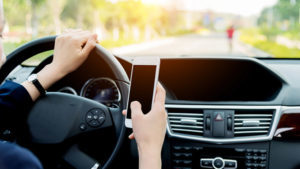
Phones are a dangerous distraction, and that’s just part of the story. GPS, radio knobs — anything that lures your eyes off the road is a threat.
The advent of the smart phone has brought with it a deluge of texting and other distractive behavior while driving a vehicle. This is no longer confined to the young and restless – we see people of all ages, genders and backgrounds using phones when they should be driving.
SAFETY THREATS
Some startling figures:
These numbers are most likely higher as drivers involved in accidents may be reluctant to admit to driving distracted.
COMMON DISTRACTIONS
While all of the following are common distractions behind the wheel, text messaging is by far the most alarming. It requires significant visual, manual and cognitive focus from the driver – three key things a driver needs to drive safely.
- Texting
- Using a cell phone or smartphone
- Reaching for something
- Eating and drinking
- Talking to passengers
- Grooming
- Reading, including maps and navigation system
- Watching a video
- Adjusting a radio, CD player or other controls in a vehicle
AWARENESS
As important as it is for us to make an effort not to drive distracted, we also need to be aware that others around us – drivers, bicyclists and pedestrians – may be distracted. While you may be able to quickly discern when pedestrians or cyclists are focused on their phones, some behaviors that may tip you off to a distracted driver include:
- Drifting around in the lane or not staying within lane lines
- Changing lanes without signaling
- Braking abruptly
- Going slower than surrounding traffic
- Driving faster, then slower again in an erratic pattern
- Failing to respond to street directional signs and signal lights
- Following too closely
DROWSINESS
Finally, distracted driving issues can be compounded by fatigue. More and more our daily demands seem to be impinging on our ability to get required sleep. Sleepiness, without fail, results in cognitive and behavioral changes that can contribute to vehicle crashes, poor work performance, accidents and other long-term physical and mental health consequences. Precise counts of crashes caused by drowsy driving are not yet possible.
Be aware of your own distractions, those who are distracted around you and the impact of driving while fatigued.
